Dietitian Does a Keto Diet
Understanding the ketogenic journey: A dietitian’s firsthand experience
Dr. Jen Carroll, a dietitian who specialises in low carb and ketogenic diets, decided to adopt a strict medical ketogenic diet for two weeks. Her goal was to experience firsthand the challenges her patients face in following this diet and conclude with some top tips for those adopting a ketogenic diet.
Motivation
In this article I focus on adopting a strict medical ketogenic diet, similar to what I recommend for my patients with epilepsy, metabolic disorders or migraines. If you are following a low carbohydrate or lifestyle keto diet for weight loss, managing blood sugars or improving overall health and wellbeing, your dietary intake will likely be more flexible with higher carb and lower fat. However, you might still find the top tips and insights here helpful for your journey!
In one of my research studies for my PhD, I interviewed parents of children who have drug resistant epilepsy to learn more about their experiences with the ketogenic diet. You can read the full published study here .
One key finding was how much parents valued having a dietitian who had personal experience with the ketogenic diet. To better understand what my patients and their parents go through, I decided to try the diet myself for two weeks to see the day-to-day challenges they might face. This experience was eye-opening. It helped me better understand what it’s like to follow a ketogenic diet, so I can offer more practical advice and support to my patients.
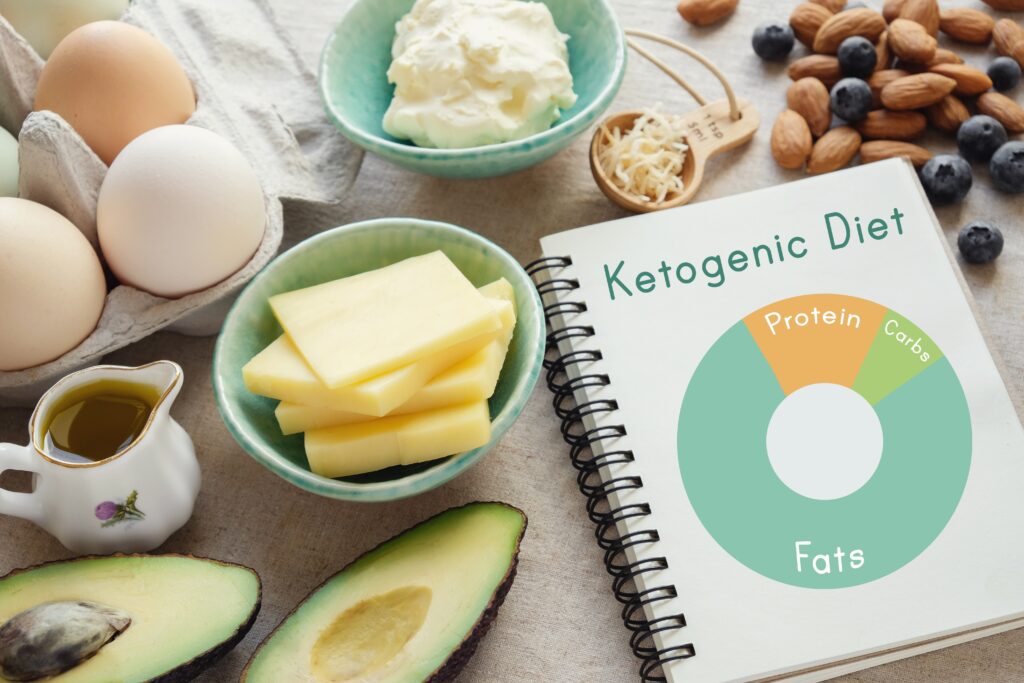
Ketogenic diets and their uses
The ketogenic diet (KD) has been used since the 1920s to treat epilepsy. It is a proven treatment for drug resistant epilepsy that doesn’t respond well to medication, both in children and adults. Many studies show that it can help control seizures. In children, about 50-60% see a 50% or more reduction in seizures, and up to 15% stop having seizures completely. For adults, around 40-50% experience a 50% or greater reduction in seizures, with 13% becoming seizure-free. The diet can also improve sleep, quality of life, behavior, and cognition.
Medical ketogenic diets are being considered for use in several disorders due to their beneficial effects on metabolic health and the nervous system. Research studies are exploring the potential for KD to treat migraines, various cancers, autism, obesity, type 2 diabetes, non-alcoholic fatty liver disease, Parkinsons, Alzheimers and traumatic brain injuries.
You might be thinking ‘she’s a ketogenic dietitian why isn’t she practising what she preaches and already following a ketogenic diet’?! The truth is I do typically follow a low-carb lifestyle with balanced levels of protein and fat. I don’t follow a strict ketogenic diet because I have no medical need to produce ketones.
Many of my patients, however, rely on the ketogenic diet for managing conditions like epilepsy, metabolic disorders, or migraines. For them, producing ketones is essential as an alternative energy source. As a dietitian, my role is to support them in starting and maintaining a medical ketogenic diet, which is very low in carbs, high in fats, and includes adequate protein. Then monitoring their progress and dealing with any side effects that may occur.
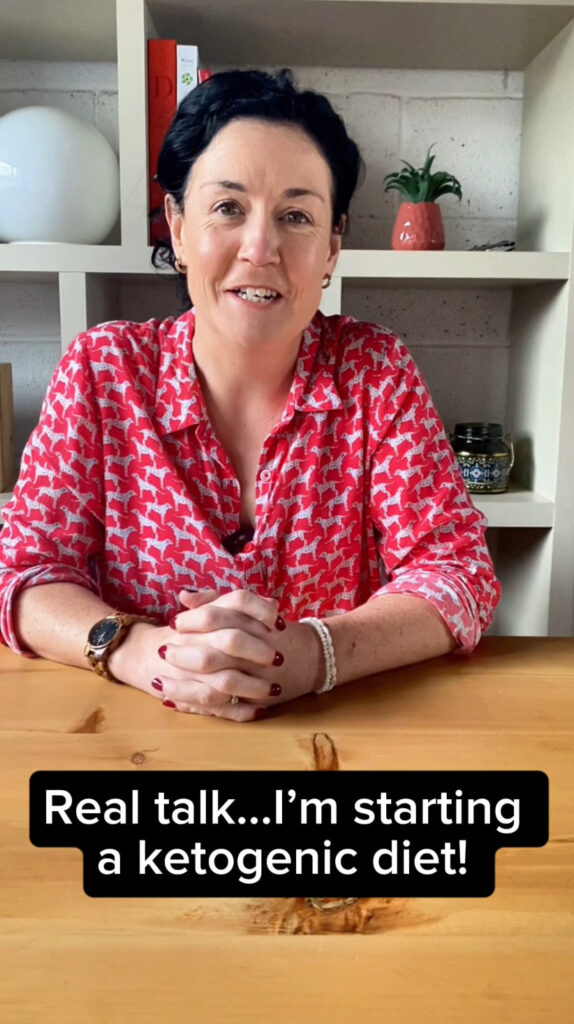
There are 5 main types of medical ketogenic diets
- Classical ketogenic diet
- MCT (medium chain triglyceride) ketogenic diet
- Modified ketogenic diet
- Modified Atkins diet
- Low glycemic index treatment
Each diet has its pros and cons. For my own experiment, I chose a Modified Ketogenic Diet, which is commonly used in the UK and Ireland. This ketogenic diet is more flexible than the classical or MCT versions, as it focuses only on tracking carbs and fats, making it easier to follow. Learn more about the different types of ketogenic diets here.
Prep prep and even more prep for keto!
Calculating my modified ketogenic diet prescription
Dietitian’s spend a lot of time calculating and customising a ketogenic diet for each individual. This involves considering things like their age, weight, activity level, current intake, food preferences and medical conditions. For my keto plan, I calculated my daily energy, protein, fat (or macros as many call them!), and fluid needs to match my usual intake and activity levels. This would help to avoid rapid weight changes. My target each day was 20 grams of carbs, 110 grams of fat and normal (not excessive) protein intake.
To give you some perspective, a typical Western diet might include up to 250 grams of carbs a day, so reducing this to just 20 grams felt like a big challenge. Ketogenic diets are very restrictive, which is why people often need supplements to make sure they get enough vitamins and minerals. For children, finding a supplement that is carb-free, tastes good and is easy to take regularly can be tricky. I planned to use FruitiVits, a powdered carb free vitamin supplement which we often use for children.

I also create ketogenic recipes for my patients, adapting their favourite meals into keto-friendly versions. So tracking carbs and fats and prepping keto meals on the fly was relatively easy for me, given my head start as a keto dietitian! But it still took more time, so for those new to the diet, figuring out how to count macronutrients and adjust recipes can feel overwhelming. That’s where dietitian’s come in, offering support and guidance throughout the process. We stage the education sessions in the prep for keto phase to help to make it more manageable.
Shopping for a ketogenic diet
With the math complete, I needed to shop for all the low-carb, keto-friendly foods I’d need. This was no small task. Living in a small, rural area meant I had to visit several supermarkets, health food stores, and order from multiple online shops to find everything. It took a lot of time, energy, and money. It’s true that keto friendly alternatives for bread, rice, pasta, snacks, flours and sweeteners are often more expensive but we often only use small quantities of these so they do last a long time. While this process could have been cheaper, I saw it as a way to explore different foods and recipes I could share (or not) with my patients later.
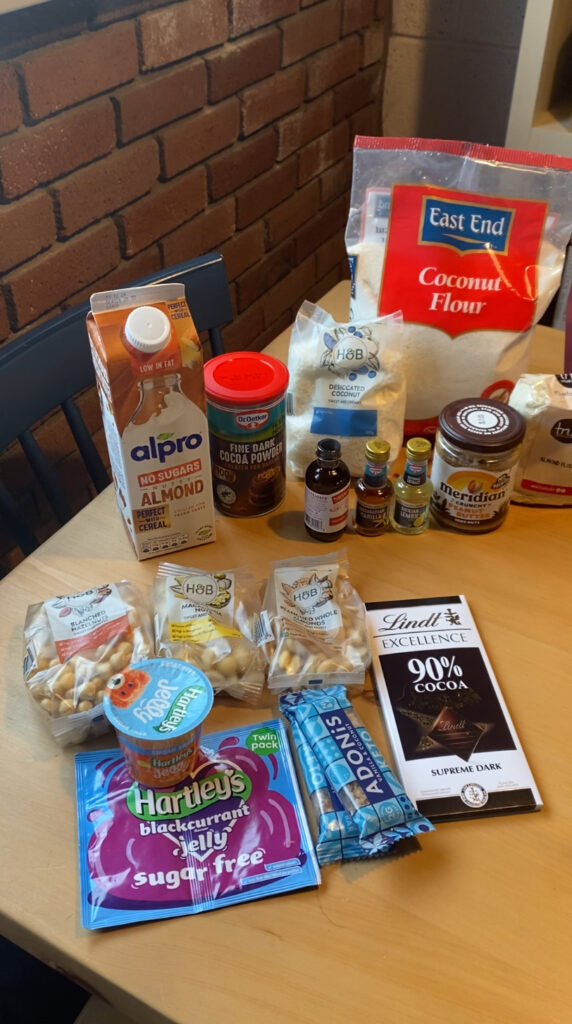
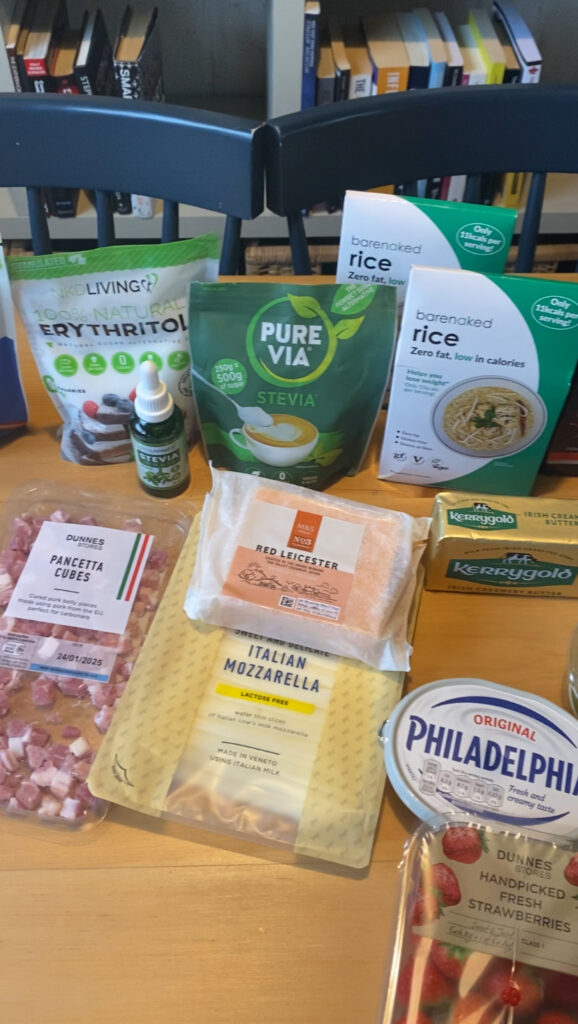
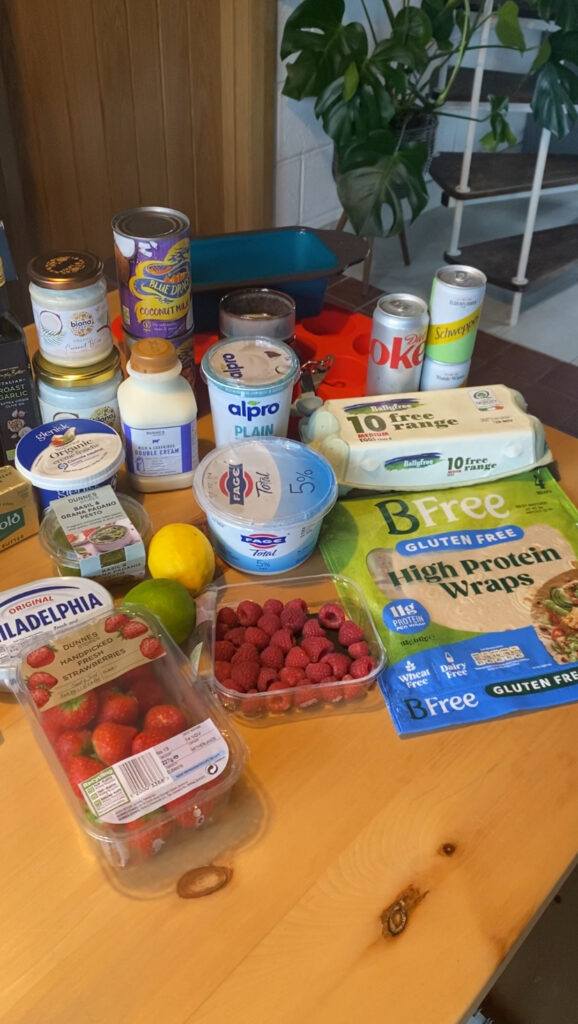
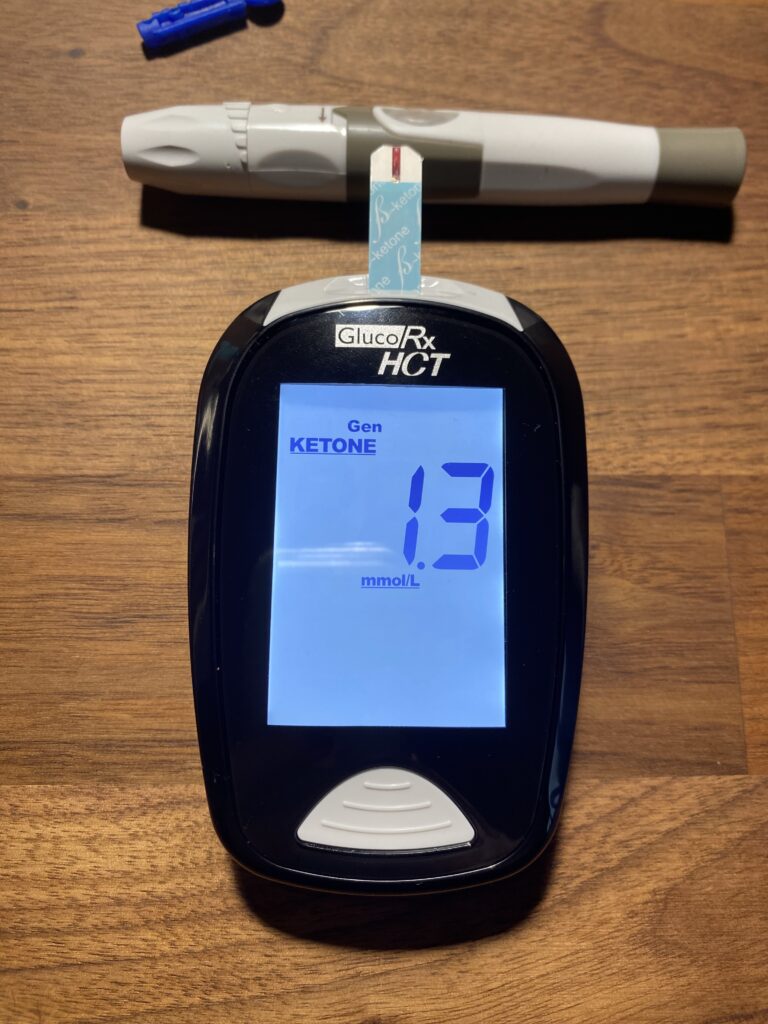
Testing ketones
I measured my ketone levels every morning and evening by pricking my finger to draw a drop of blood and using a Gluco Rx HCT meter, which tests both blood glucose and ketones.
Target ketone levels can differ for each person, but for children, we usually aim for 2-6 mmol/l. Adults don’t tend to produce ketones as efficiently as children so it’s rare to hit high numbers of 4-6mmol/l.
For adults, the main goal is to first enter ketosis, then individually assess optimal ketosis levels. For me, my ketones reached a peak of 2.6 mmol/l, even though my carbs were as low as 15g/day and my fat intake went up to 130g.
Getting started on the diet – is keto flu a real thing?
When starting a keto diet, we force the body to switch from using glucose (from carbohydrates) to ketones (from fat) as its main energy source. This change can bring on various symptoms, often called “Keto Flu.” To help our patients avoid these symptoms, we usually ease them onto the keto diet over 5-10 days. But I decided to dive straight into the full keto diet from day 1 to see what the transition was really like.
On day 1, my ketone levels were 0.1, then on day 2, they went up to 1.3, and by day 3, they hit 2.4 mmol/l, showing I was quickly entering ketosis. I have to admit, it wasn’t an easy experience. I felt lightheaded, super tired, and had brain fog that made even simple tasks like basic math challenging. I love cooking and often batch cook or cook multiple meals at once, but I found myself struggling to coordinate making a keto-friendly Thai curry for me and a non keto meal for my husband! On day 2, I had to take a long afternoon nap, something I rarely do.
I also felt very thirsty, which I expected, so I drank lots of water to stay hydrated. I lost 2 kg in weight, likely from losing water in the initial phase. So while “Keto Flu” is definitely real, it’s not as bad as the regular flu because it passes more quickly and doesn’t cause a sore throat, dry cough or fever.
Thankfully, by day 3, I felt full of energy and mentally sharp again. After that, I didn’t experience any more issues with energy and felt like my usual self on the keto diet.
Potential challenges with a ketogenic diet and solutions
| Potential challenges | Potential solutions |
| Cost of low carb foods It’s tempting to spend a fortune on lots of different ingredients when starting KD | 1. Don’t feel you have to buy everything all at once! 2. Start by sourcing low carb versions of the foods you really enjoy to help make your diet easier and more convenient. For example, low carb bread or bagels can bring sandwiches back into your meal options. 3. Talk to your dietitian and check out Matthew’s Friends and The Charlie Foundation for budget friendly recipe ideas |
| Food wastage It can be discouraging if a recipe you’ve spent a lot of time preparing doesn’t turn out as expected or is refused by your child | 1. Taste the dish as you cook—everyone’s preference for sweetness, spices, and flavours varies, so adjust accordingly. 2. When trying a new recipe, make a small portion first to see if your child likes it before making a larger batch |
| Time management There is no denying that following a ketogenic diet can be time consuming, especially in the beginning – even for a Dietitian! This is completely normal, and it will get easier. | 1. Your first few grocery shopping trips will take longer as you’ll need to check food labels, but this will become quicker and easier over time. 2. Start with simple meals—eating the same meals regularly is normal, and children often enjoy familiarity. 3. Ask friends or family for help with batch cooking meals and keto-friendly snacks, such as keto muffins. 4. Store extra meals and snacks in the freezer for quick and easy access when needed. |
| Others don’t understand Many people think keto is just a trendy or fad diet because it’s so popular online. They might not understand that for you or your child, it’s actually a serious medical treatment, not just a lifestyle choice. | 1. Take the time to explain the diet to your family and friends, emphasising its importance for you or your child and the positive affects you hope it will have. By doing so, you can reduce misconceptions and help them to understand the daily challenges, as well as how they can offer support. 2. Your dietitian can provide information sheets, and there are many explainer videos on the Matthew’s Friends web page. |
| No days off We can’t take a break from medical ketogenic diet. Doing so can lead to a loss of ketosis and any positive benefits experienced. | 1. Plan ahead for occasions like birthdays, school trips, holidays and Christmas 2. Your dietitian can help you with occasion recipes like birthday cakes 3. Try to plan celebrations that are not food based – go to soft play centres or a picnic with keto snacks and cake or offer non-food treats like magazines, small toys etc. |
Key insights and lessons learned from following a keto diet
Keto is doable!
Yes adapting to a keto diet comes with challenges BUT the potential benefits especially for children and adults with epilepsy can be life-changing for them and their families.
Start with a low-carb approach
When getting ready to follow a medical ketogenic diet, it’s important to begin to cut back on carbohydrates to help the person adjust. This means swapping out high-carb foods for lower-carb alternatives. Here’s how:
- Skip sugary drinks and fruit juices. Instead, go for water, or sugar-free and zero-calorie versions
- Swap out sugar and honey for carbohydrate and calorie-free sweeteners like Stevia or erythritol
- Cut down on portions of bread, rice, pasta, and cereals
- Pick lower-carb fruits like strawberries, blackberries, and raspberries
- Go for lower-carb vegetables like broccoli, cauliflower, kale, spinach, spring onions, salad greens, and aubergine (eggplant)
- Remove high carb foods like crips, biscuits, cake, chocolate and sweets from the diet.
Food as fuel
I started seeing food as fuel rather than something just for enjoyment. Kids naturally think this way, but as adults, we often eat for pleasure or cravings. My appetite was a lot lower than normal. This was likely due to being ketotic and the satiating effect of the high fat meals left me feeling fuller, so I didn’t crave or miss foods that I thought I’d struggle without. This made following the diet a lot easier.
Dedication and determination
I was surprised at how many people encouraged me to ‘cheat’ or take a break from the diet. This was likely fuelled by them knowing I was doing this as a learning experience and not out of clinical necessity. I now understand how frustrating it can be to have to defend this choice repeatedly. Parents can sometimes feel like they are depriving their child of typical treat foods like chocolate, crisps etc. or made to feel like they are. One mum I interviewed, whose little boy had achieved good seizure control and other benefits from a ketogenic diet summed it up perfectly when she shared ‘ there’s no chocolate bar out there that I worth going back to how he was’.
Cooking and baking
At first, I was super motivated to try all kinds of keto recipes. But over time, I realised that sticking to a few key favourites worked best. You don’t always need to hunt for new recipes—simple and reliable options can be just as satisfying.
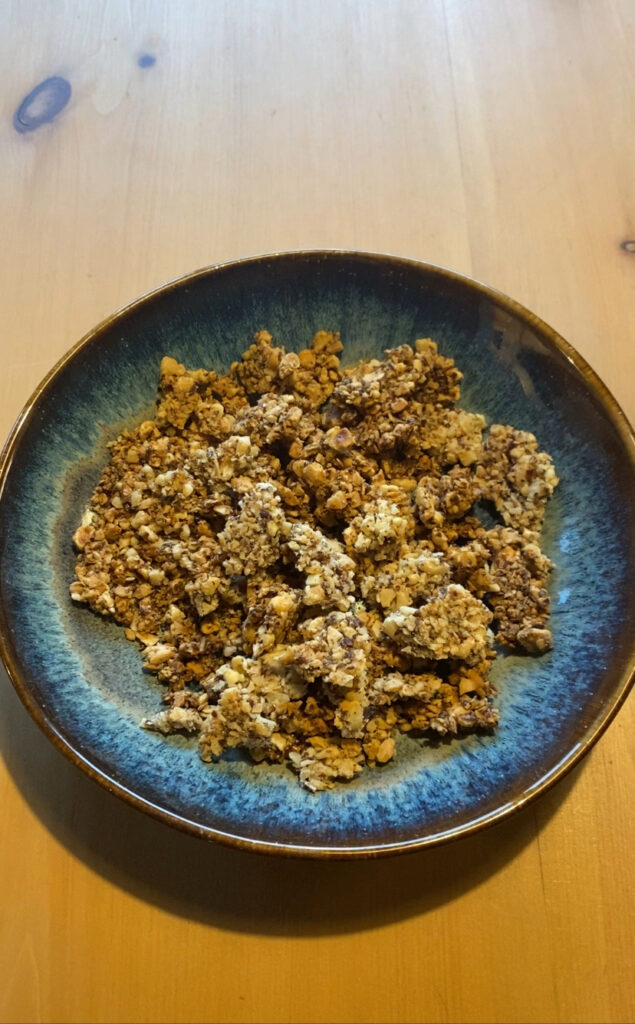
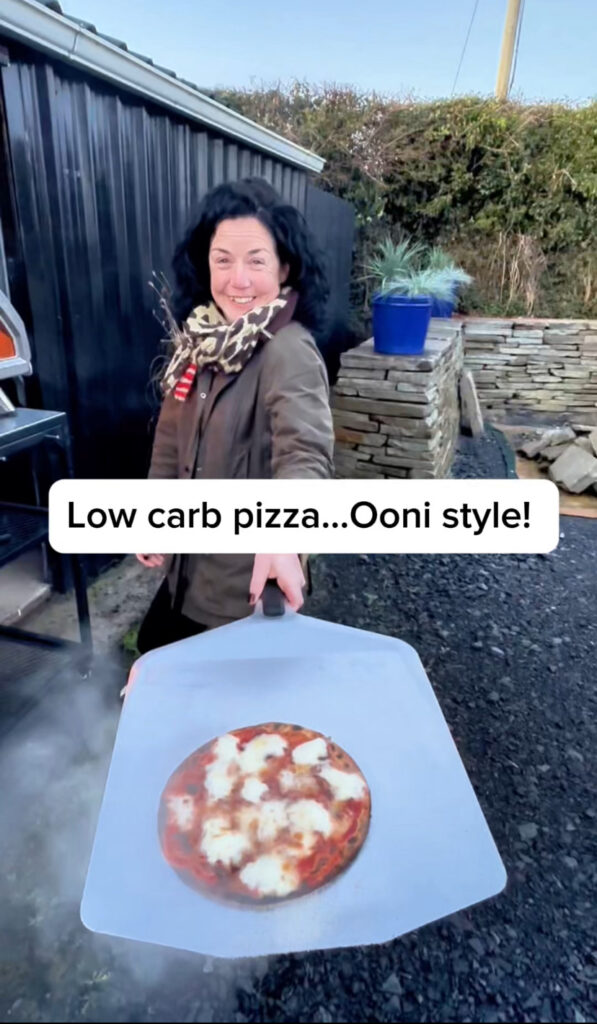

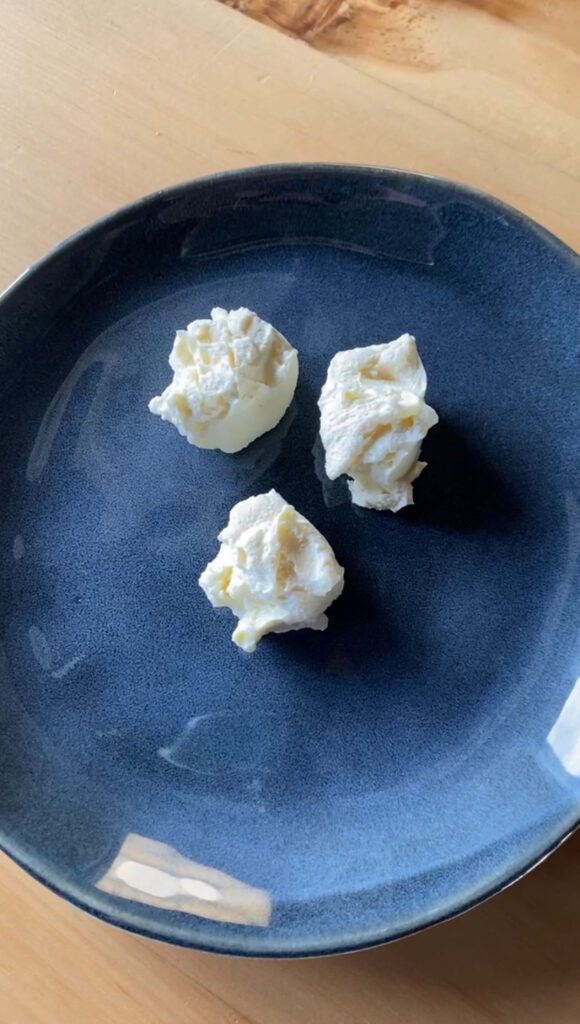
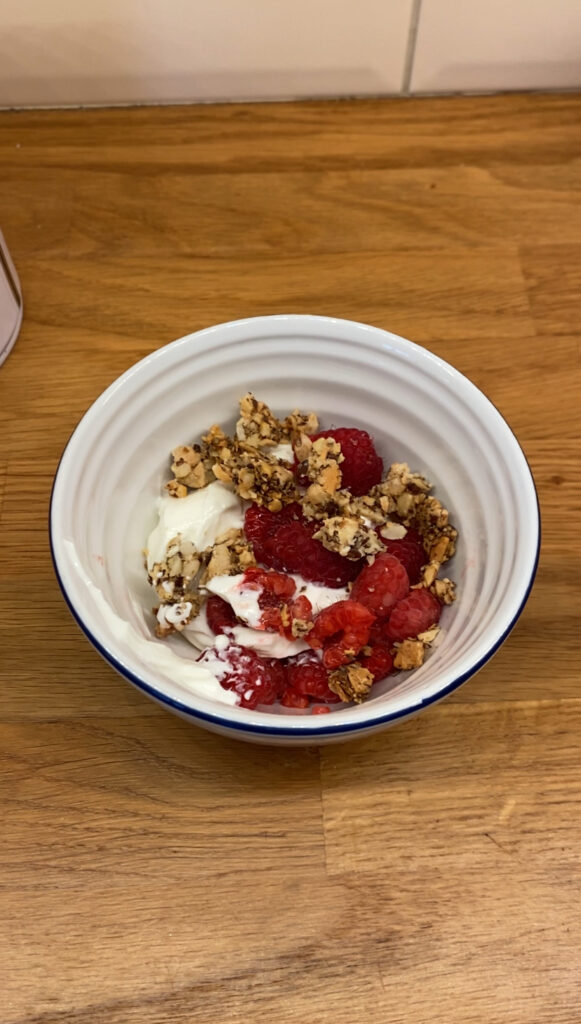
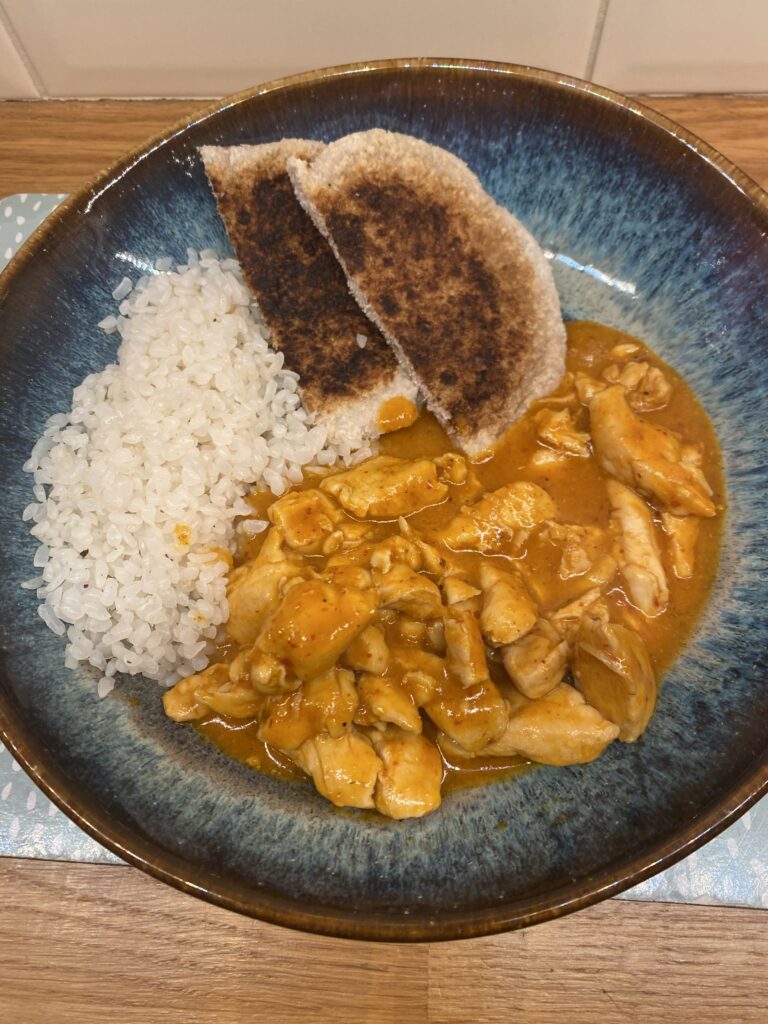
Snacks
I ate a lot of nuts and keto muffins as snacks especially when travelling. These together with fat bombs (great with a coffee!) helped me to keep my daily fat intake up. Also, the nuts contained lots of fibre and the muffins had added fibre from flaxseeds and psyllium husks which saved me from dealing with issues like constipation.
Travelling on a keto diet
At home, my carb intake was as low as 15-20g but when travelling I found it increased to 20-25g because I relied on more nuts to meet my fat target. Nuts are low carb, but they do add up when eating a lot of them! I found K Yo, a prescribable keto dessert and KetoCal; a keto shake were really helpful when travelling as both provided a reliable high dose of fat with very low carbohydrate content. We need to plan ahead for children or adults when travelling to ensure they have a good range of fats available to them and they bring a supply of any prescribed keto friendly shakes, desserts or supplements that they are taking, as carb fluctuations like these could disrupt their seizure control. Check out some top tips for travelling here when I travelled to Italy to speak at a conference.
Texture is important
Some people can be very sensitive to changes in preferred food textures while others adapt brilliantly. Carb free noodles, rice and pasta are often made with konjac flour and can replace normal rice, noodles or pasta. For me, the texture was hard to get used to, so I skipped them. Instead, I enjoyed alternatives like low-carb wraps toasted with a curry.
A little bit of what you like!
Dietitian’s help you to understand the carbohydrate content of different foods and how to ‘spend’ your carb allowance wisely, choosing lower carb options to get larger portions. BUT sometimes having a smaller portion of a favourite food is more valuable!
For example, at a family dinner, I really fancied carrots and potatoes rather than a huge plate of much lower carb broccoli and cauliflower, so I had 3 roasted carrot sticks and a tiny roast potato with chicken and gravy made from the juices. I followed this with a high fat dessert; K Yo (1.5g carbs and 30g fat) to boost my fat intake. It was a small meal, but I really enjoyed it for a change.
Vitamins and minerals
Even as a dietitian, I forgot to take my daily vitamins and minerals a few times! This really surprised me but at the same time reminded me how important it is to create a habit. Placing them next to my coffee machine helped me to remember each morning. Parents often give them to children with their regular anti-seizure medications so they become part of that morning or night time routine.
Reframing food norms
We’re used to certain foods at specific times—like cereal for breakfast or savoury dinners. On keto, those norms change and that’s ok. Some mornings, I had a chocolate muffin for breakfast, and for dinner; Greek yogurt with berries and double cream. Neither would be a typical meal for me but they met my target macros, tasted great, and worked for the diet. This can be particularly challenging for parents if they feel judged by those around them for giving their child what are perceived to be naughty ‘junk’ foods when in fact the keto versions are perfect for their child’s keto plan.
Experimenting with flours
There are many keto-friendly flours like almond, coconut, konjac, flaxseed and psyllium husks. Finding the right one takes experimentation. I love anything coconut flavoured so I assumed I’d enjoy muffins or chapatis made with it. However, I found the texture dense and the favour very overpowering. Almond flour worked much better for me.
Conclusion
I hope sharing my experience with trying a ketogenic diet has been helpful. I wasn’t following it to manage seizures, migraines, weight loss, or type 2 diabetes, so I didn’t expect the benefits people with those conditions often see. However, many of my patients talk about their brain fog clearing up, feeling more focused and productive, and having more energy overall. I can now understand why many people report successful weight loss with a keto diet. I wasn’t aiming to lose weight but I was so surprised at how low my appetite was and how little I craved the foods I expected to miss. This reduced hunger and cravings really helps people who want to lose weight. What isn’t clear is if we need to be in ketosis to experience this reduced hunger. Many of my patients achieve this on a low carb diet but others do need to be in low level ketosis.
Trying this strict diet myself has helped me understand what patients and their families go through and find practical ways to support them. Keep in mind, not everyone needs such a strict approach. For many, a low or very low-carb diet can be enough to see positive changes and manage symptoms.
If you need help figuring out the right approach for you, feel free to reach out!



